
1840s NYC: Urban Progress, Cultural Renaissance & Technological Advances
The 1840s were a pivotal decade in the history of New York City, marked by substantial progress and transformation. This era witnessed significant urban development, setting the stage for the city’s emergence as a bustling metropolis. The completion of pivotal infrastructure projects, notably the Croton Aqueduct in 1842, played a crucial role in improving living conditions and supporting the city’s burgeoning population.
Architecturally, the 1840s saw the construction of new buildings and landmarks that would become cornerstones of New York City’s identity. The establishment of the New York Stock & Exchange Board during this period was a milestone in the city’s economic history, heralding its rise as a burgeoning financial center. Additionally, the expansion of the city’s boundaries, incorporating areas that would later become key boroughs, mirrored the broader trend of urban growth.
Culturally, New York City in the 1840s became a mosaic of diverse communities, enriched by the influx of immigrants. This diversity significantly shaped the city’s social and cultural landscapes. However, the era also faced challenges, including public safety concerns and the pressing need for improved infrastructure to support the rapidly expanding population.
In summary, the 1840s were years of dynamic change and growth for New York City. The advancements in infrastructure, cultural diversity, and economic development during this decade were instrumental in shaping the city’s future trajectory. The legacy of the 1840s remains a significant chapter in the history of New York City, underscoring its evolution into a modern and diverse urban center.
1840’s Timeline of New York City’s History, USA
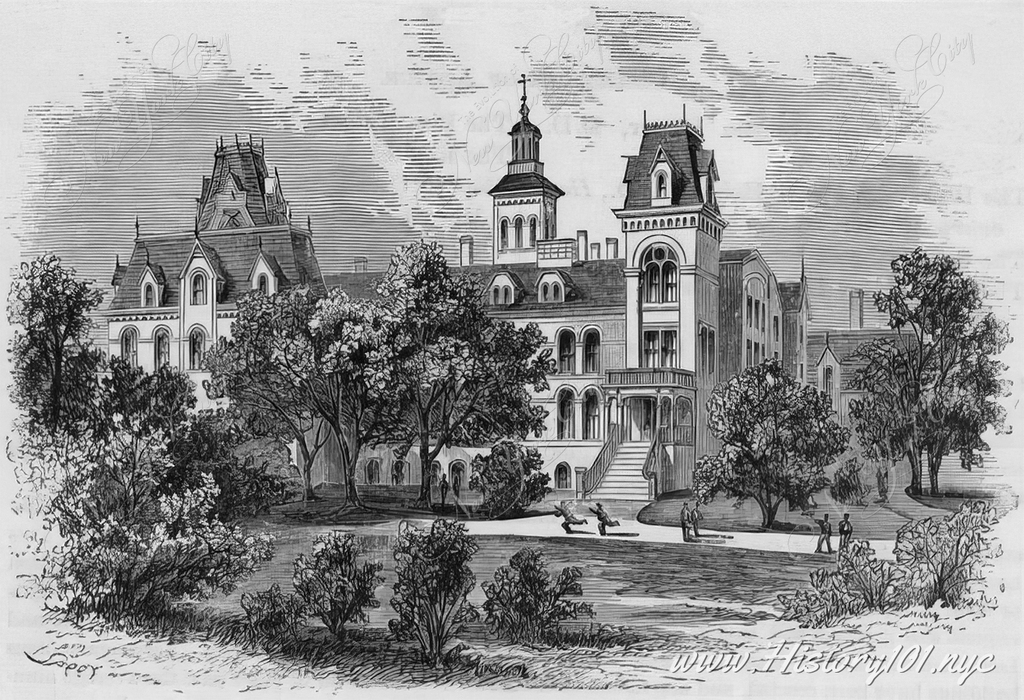
1840: The Association for the Benefit of Colored Orphans
Illustration of the original building that housed the Association for the Benefit of Colored Orphans

1840: Castle Garden's Evolution: From NYC's Cultural Beacon to Immigration Gateway
"Discover Castle Garden's transformation from a cultural center to America's first immigrant station, shaping NYC's diverse history
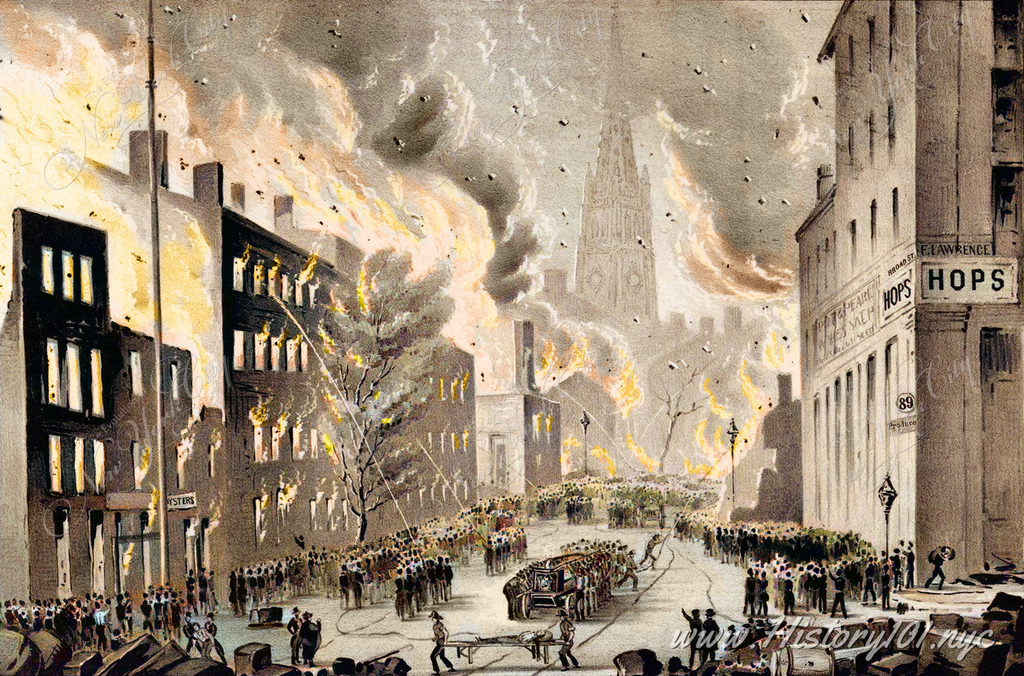
1845: NYC's Great Fire: Resilience and Innovation Shaping Urban Safety
Discover how NYC's response to the 1845 Great Fire revolutionized urban fire safety, fostering resilience and community strength
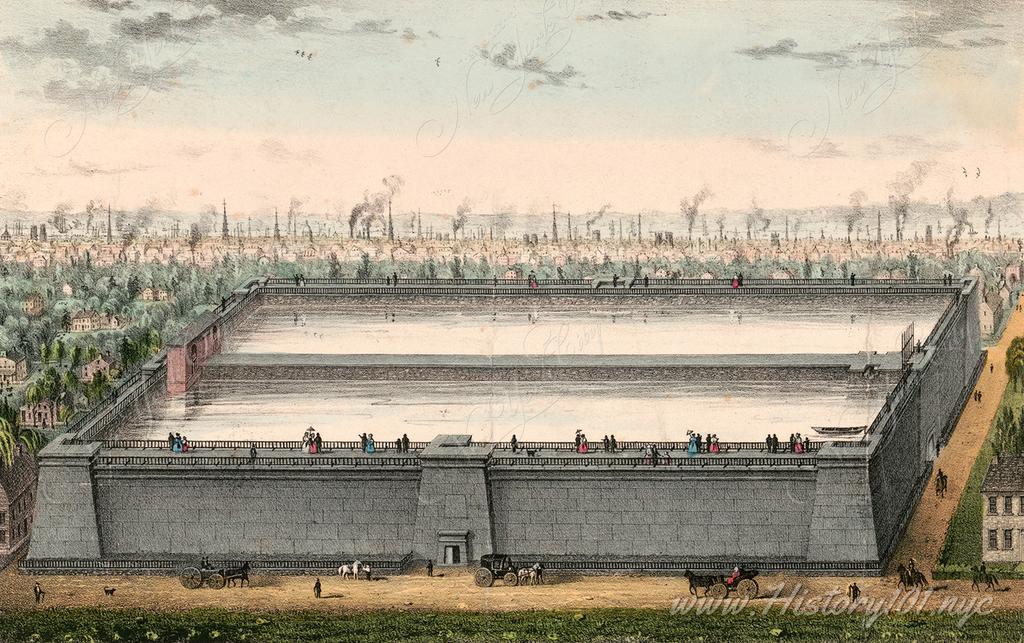
1842: Murrays Hill
View of the Murrays Hill Reservoir - the terminal, or distributing, reservoir of the original Croton Aqueduct.
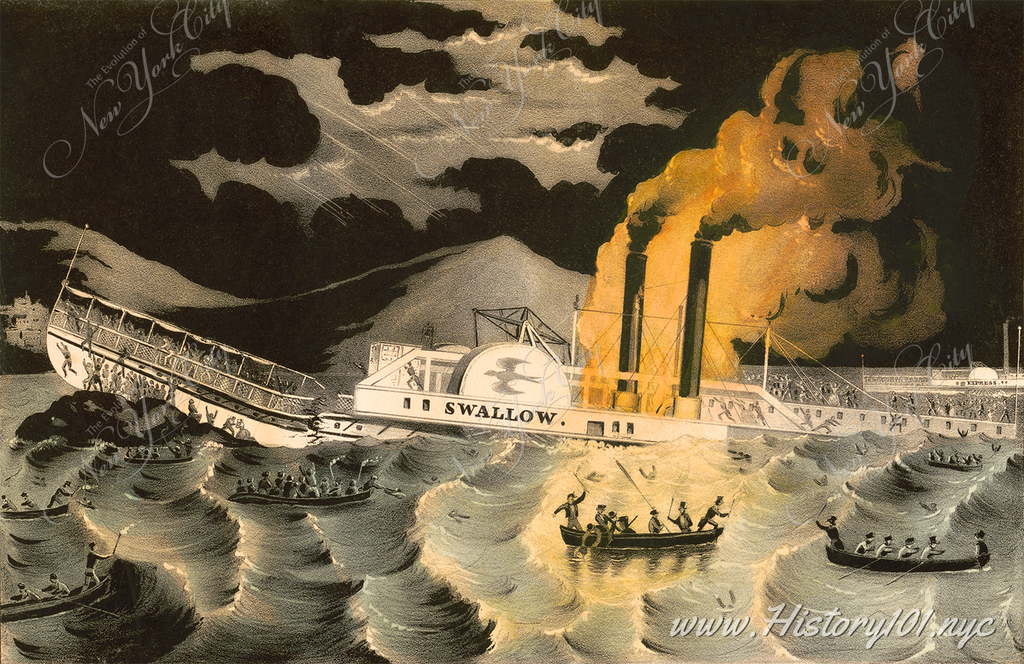
1845: The Sinking of the Swallow: A Turning Point in Maritime Safety Reform
Explore the tragic sinking of the steamboat Swallow in 1845, a critical event that underscored the dangers of early steamboat travel

1845: Union Square Park
Sarah Fairchild's painting, "Union Park, New York," offers a captivating glimpse into the early history of American landscape design and the role of public parks in 19th-century urban life.
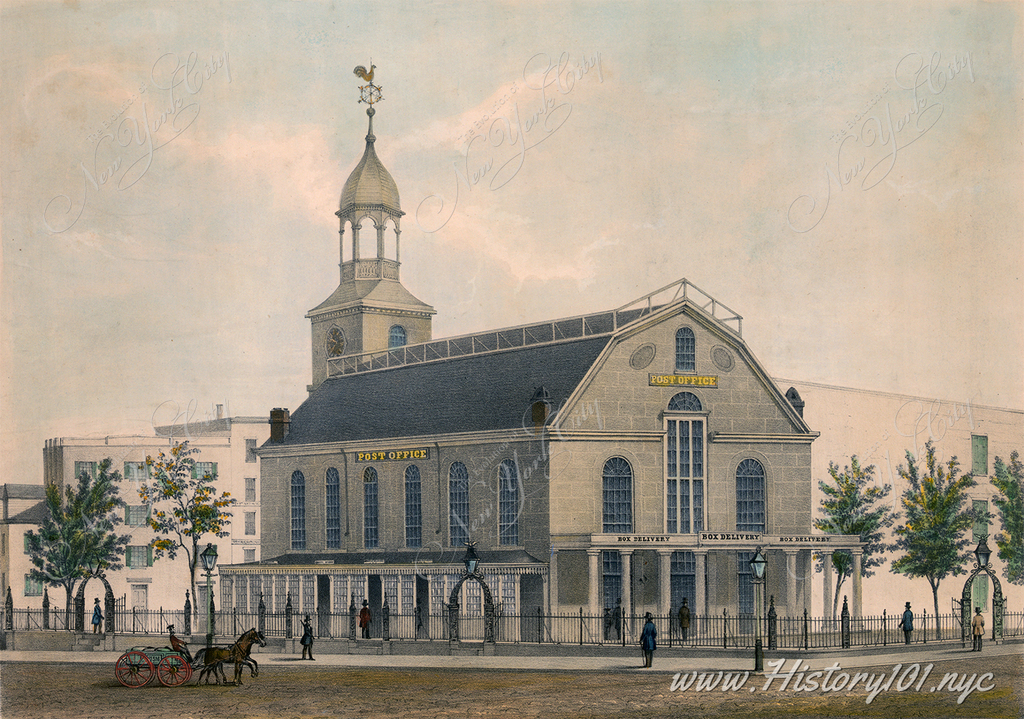
1845: New York Post Office: Architectural Marvel & Communication Hub
Explore the 1845 New York Post Office illustration, highlighting its pivotal role in urban development and national connectivity

1845: Interior View of New York Post Office
This lithograph, illustrated by G. & W. Endicott in 1845, captures a historical glimpse of the interior of the New York Post Office.

1846: Saint Paul's Church on Broadway
St. Paul's Chapel, located at 209 Broadway in New York City, is a historic chapel that was built in 1766, making it the oldest surviving church building in Manhattan.
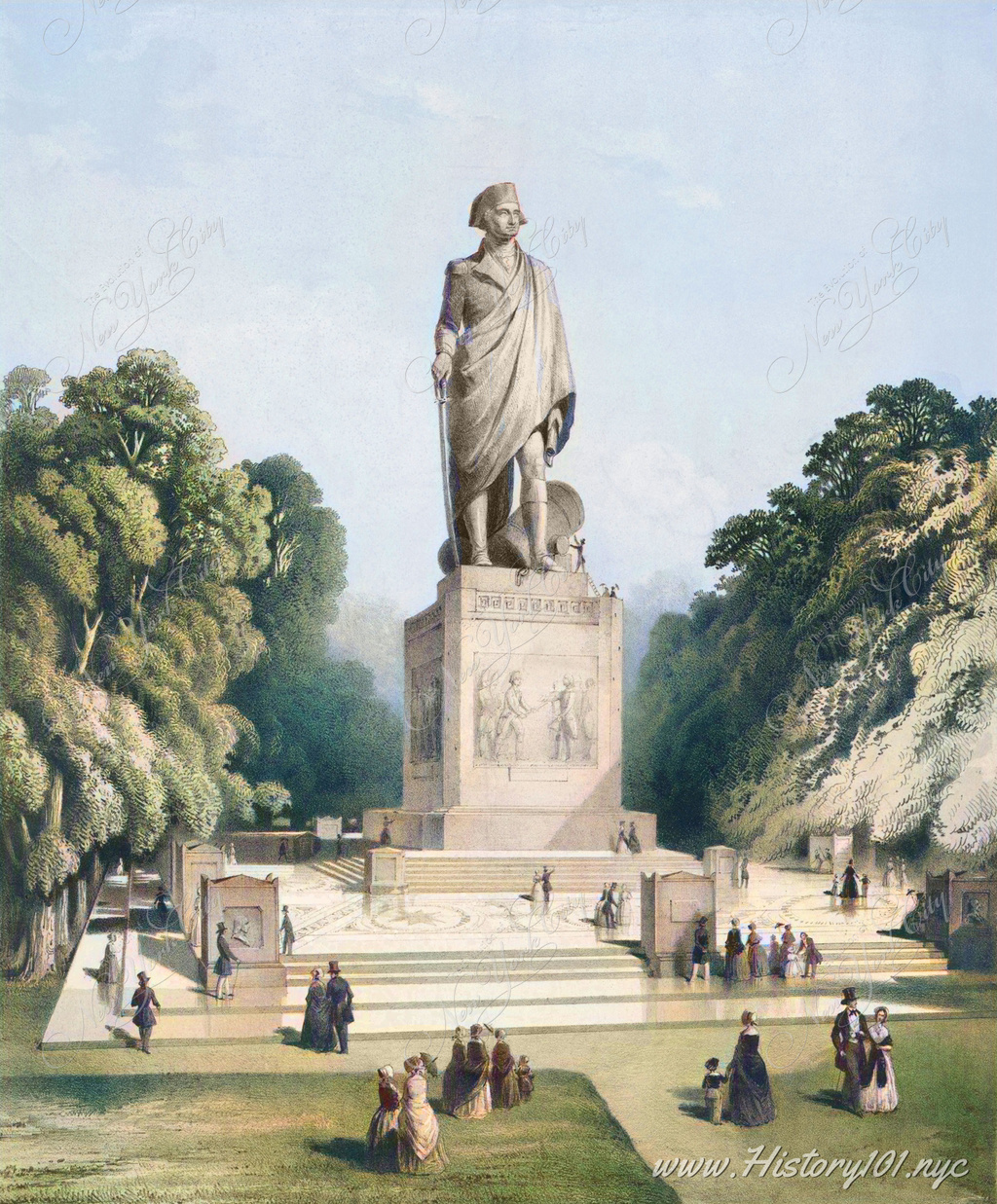
1845: Proposed Colossal Statue of Washington
This stone engraving by G.Thomas depicts the grand vision of a colossal statue of George Washington proposed for New York City in 1845.
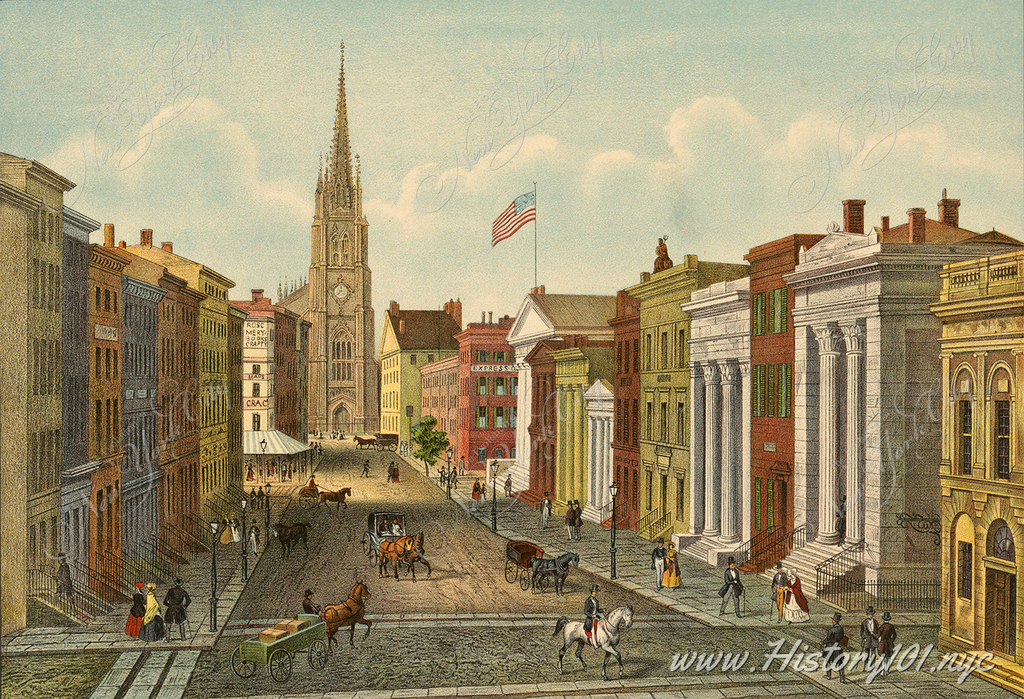
1847: Wall Street
Illustration of the Financial District in lower Manhattan, the cobblestone streets are filled with the activity of horses, carriages and pedestrians.
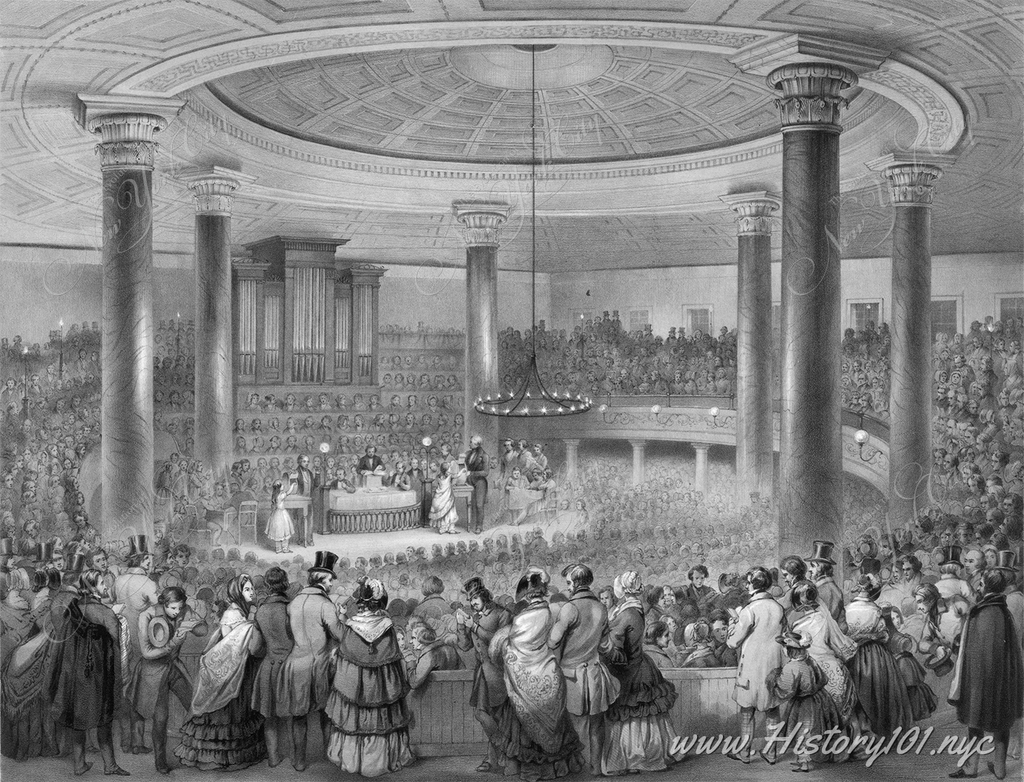
1847: American Art Union at Broadway Tabernacle
Print shows a large audience at the Broadway Tabernacle attending the annual distribution of the American Art Union prizes and lottery of paintings by American artists.
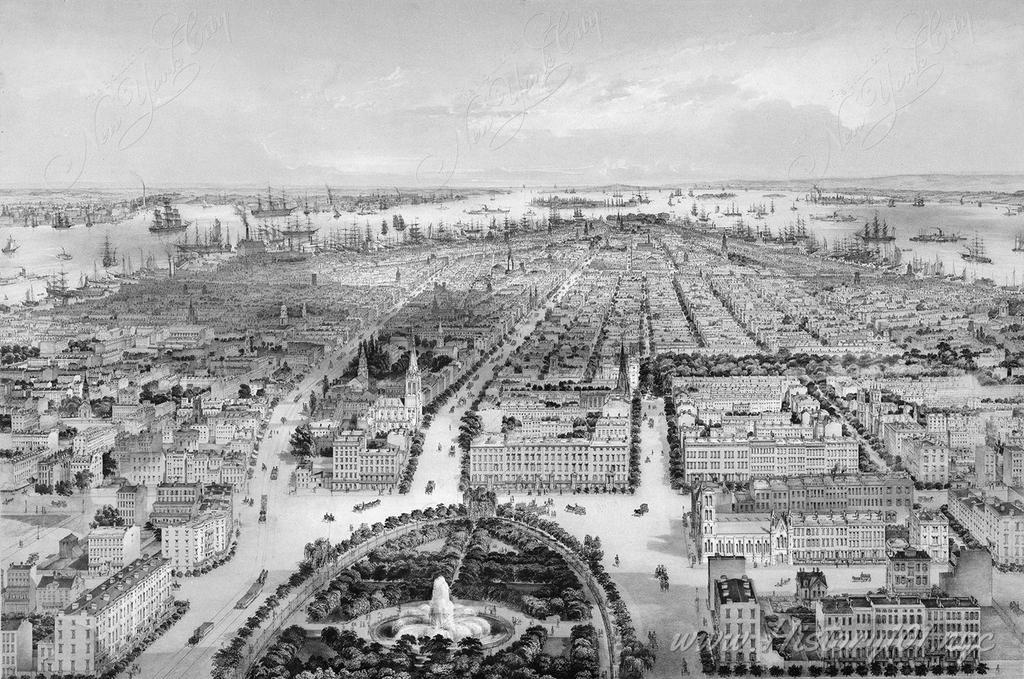
1849: Aerial View of New York City
Black and white etching of Manhattan looking south from a bird's eye perspective. Union Square Park is visible in the foreground.

1849: Grace Church
Black and white etching of Grace Church at its uptown location. The church was initially organized in 1808 at Broadway and Rector Street.
Timeline of New York City: 1840-1850
1841: Featured on an 1841 map, Flushing Park, later renamed Daniel Carter Beard Memorial Square, stands out as a historic landmark in Queens. This park is highlighted for its longevity and potential as one of the borough's oldest public spaces, emphasizing its enduring importance in the community.
In Jamaica, Queens, the acquisition of Wyanda Park in 1844 marks a key moment in the expansion of public recreational areas. These early developments in park spaces not only enhance the green landscape of Queens but also mirror the broader evolution of public parks within the urban fabric of New York City, reflecting significant growth and cultural shifts.
1841: Born in New York City on January 10, George W. Melville became a pivotal figure in American naval engineering and polar exploration. As the U.S. Navy's Chief Engineer from 1887 to 1903, he was renowned for his significant advancements in shipbuilding and propulsion technologies. His heroic survival and leadership during the Jeannette Arctic expedition notably enhanced his legacy, contributing greatly to the fields of exploration and naval construction.
Melville's career was marked by innovations that dramatically improved the efficiency of naval operations, influencing modern naval engineering profoundly. His death on March 17, 1912, marked the end of a career that had a lasting impact on America's technological capabilities and its exploration narrative. Melville's work not only pushed the boundaries of technology and exploration but also helped cement the strategic role of naval engineering in national defense and scientific advancement.
1841: New York City's trial of an early U.S. steam fire engine on March 27, showcased a major stride in firefighting technology. This innovation, which pumped water more efficiently than manual methods, was crucial for urban fire safety evolution, representing a shift from traditional hand-pumped models to more effective steam-powered solutions.
This development underscored New York City's dedication to enhancing safety and infrastructure during a period of rapid growth. The steam fire engine improved firefighting by offering faster response times and superior fire suppression, meeting the needs of an expanding, densely populated city. By embracing such technological advancements, New York City affirmed its status as a leader in pioneering urban management solutions, reinforcing its commitment to public safety and technological progress.
1841: Mary Cecilia Rogers, "The Beautiful Cigar Girl," mysteriously disappeared from a popular Manhattan cigar store, sparking a major news story in New York City. Her body was found in the Hudson River on July 28, suggesting murder, but her death's cause remains unsolved. This incident, marked by unresolved mystery and media frenzy, deeply impacted NYC's history and public consciousness.
The extensive media coverage of Rogers' case signified the burgeoning power of urban newspapers. Despite high public interest, the murder mystery was never solved, enhancing its notoriety. Edgar Allan Poe's "The Mystery of Marie Roget," inspired by this case and published in 1842, is a milestone in detective fiction.
1841: Acquired by showman Phineas T. Barnum, the American Museum quickly became a Manhattan landmark, drawing diverse crowds with its eclectic array of oddities, artifacts, and performances. This establishment was central to mid-19th century New York City's cultural and entertainment evolution, symbolizing the era's fascination with the unique and spectacular.
The Dodworth family, notably the Dodworth brothers, significantly shaped the city's 19th-century music and dance culture. While the founding date of Dodworth's Dancing School remains uncertain, their role in popularizing European dance and music styles in New York was influential, molding social dance customs and musical preferences of the time.
1841: Napoleon E. Guerin patented the cork life preserver on November 16, revolutionizing maritime safety with a device that offered reliable flotation thanks to its use of cork—a buoyant and water-resistant material. This innovation significantly improved survival mechanisms for sea travelers, marking a leap forward from previous, unreliable life-saving technologies.
In New York City, a bustling maritime center, the introduction of cork life preservers dramatically enhanced the safety of its extensive shipping and passenger operations, crucial to the city's economic backbone. Guerin's life preservers not only increased survival rates in maritime incidents but also supported the city's development into a major hub for safe commercial and maritime exchanges, bolstering its reputation as a leader in maritime safety and commerce.
1842: Alexander Greig's City Despatch Post in New York City launched the first adhesive postage stamps in the U.S. on February 1. These innovative stamps, featuring George Washington's image, allowed users to affix them directly to envelopes, streamlining mail processes within the city. This breakthrough marked a significant advancement in postal service efficiency and was initially exclusive to New York City, setting a standard for future developments in postal systems.
Later in 1842, the U.S. Postal Service absorbed City Despatch Post, integrating this new stamp usage into its national operations. This early adoption of adhesive stamps by a major urban postal network underscored the initiative's success and importance, promoting New York City’s role as a pioneering center for commercial and communication advancements. The enhancement of mail services through these stamps contributed significantly to New York’s development as a bustling hub during an era of intense growth and urbanization.
1842: George Bruce secured the first U.S. design patent for typefaces and borders on November 9, in New York City. This landmark patent, recognized by the United States Patent Office, was pivotal in the evolution of the printing and type founding industries. Bruce’s work not only improved the visual appeal of printed materials but also brought efficiencies that revolutionized the printing process, setting a standard for intellectual property in the industrial arts.
New York City's role as a hub for innovation was further cemented by this achievement, highlighting its significance in the national arts and business sectors. The protection offered by the patent spurred innovation and attracted a wave of skilled workers and entrepreneurs, boosting the city’s reputation as a leader in commerce and technological advancement. This period marked a significant contribution to New York's legacy as a center for creative and industrial progress.
1842: Constructed between 1837 and 1842, the Croton Aqueduct was a pivotal solution to New York City's acute fresh water shortage, addressing contamination issues from dense population, industry, and livestock. Spanning 41 miles from the Croton River to Manhattan, it effectively curbed waterborne diseases and fire hazards, enhancing public health and safety.
The Aqueduct, completed on June 22, 1842, was a significant early 19th-century engineering feat, notably for its gravity-fed system. It not only ensured a steady, clean water supply but also set a benchmark for subsequent urban infrastructure, aiding in the city's ongoing expansion and progress.
1842: Two pivotal institutions were established in New York City: the Philharmonic Society, now known as the New York Philharmonic, and the Board of Education. The Philharmonic Society, one of America's oldest musical organizations, significantly enhanced the city's cultural landscape by making classical music widely accessible, thereby solidifying New York's status as a cultural and artistic hub.
Simultaneously, the inception of the Board of Education represented a transformative shift in educational policy, setting the foundation for the modern public school system. This move towards more systematic and inclusive education played a crucial role in fostering social and economic growth in New York, through improved literacy and educational opportunities.
1843: The Olympic Theatre in New York City launched the first U.S. theatre matinee on December 25, pioneering afternoon performances that catered to a broader audience, including families and those unavailable in the evenings. This innovation expanded access to theatrical entertainment and marked a significant evolution in how theater accommodated diverse audience needs.
This strategic move enhanced cultural accessibility, setting a national precedent for performance scheduling that other cities soon emulated. The introduction of matinees helped solidify New York's status as a leader in cultural innovation, reinforcing its role as a central hub for arts and entertainment in America, driving broader participation and engagement in the theatrical arts.
1844: New York City revolutionized its law enforcement by forming its first uniformed police force, a precursor to the New York City Police Department (NYPD). This transformation from watchmen and constables to an organized police entity represented a significant stride towards modern policing and public safety management.
This change was driven by the city's rapid growth, industrialization, and escalating population. The new force was tasked with instilling order and professionalism in law enforcement, crucial for an expanding urban setting. This pivotal move in 1844 laid the foundation for today's law enforcement methods and played a key role in New York City's ongoing social and economic progress.
1844: The New York Yacht Club (NYYC) was founded and quickly became a key player in yachting and maritime recreation, enhancing New York City's cultural and sporting profile. As one of America's top yacht clubs, it played a crucial role in developing yachting as both a sport and leisure activity, strengthening the city's connection to maritime traditions.
Gaining global recognition through its involvement in the prestigious America's Cup from 1851, the NYYC elevated New York City's status in the international sports arena. It also served as a social hub for the city's elite, influencing the social dynamics and leisure culture of New York City.
1844: Mathew Brady, celebrated for his Civil War photography, opened his first studio in New York City, marking a pivotal moment in photographic history. This establishment became a cornerstone in the city's cultural legacy, renowned for its innovative and artistic contributions to photography.
Brady's studio profoundly influenced photography's evolution as an art and documentation medium, offering a crucial visual narrative of American society in a transformative period. It also served as a training ground for upcoming photographers, significantly shaping the photographic field and enriching New York City's artistic scene.
1845: Edgar Allan Poe's iconic poem "The Raven" first appeared in The Evening Mirror, a New York City newspaper, on January 29, 1845, marking a pivotal moment in his career and in American poetry. Celebrated for its evocative language and haunting meter, the poem became an instant classic, enhancing Poe's reputation and underscoring the city’s significance in the literary world.
While Poe crafted "The Raven" before residing at what is now the Edgar Allan Poe Cottage in the Bronx, the farmhouse where he penned this masterpiece was in the nearby village of Fordham, pre-dating his move to the cottage in 1846. Today, the cottage serves as a museum commemorating his literary achievements and his time in New York, highlighting the city’s role as a cradle of artistic and cultural innovation during the mid-19th century.
1845: Joseph Francis, an inventor from New York City, was granted a patent for a corrugated sheet-iron lifeboat on March 26. His innovation employed corrugated iron to reinforce lifeboats, vastly increasing their durability and safety compared to traditional wooden models. This breakthrough addressed the critical need for more dependable life-saving equipment in maritime ventures.
This patent underscored New York City’s prominence as a center for industrial innovation, particularly benefiting its robust maritime sector. By improving safety standards with corrugated iron lifeboats, New York enhanced its economic and commercial development as a leading global port. This advancement not only bolstered the city’s maritime operations but also set a precedent for future safety innovations in shipping industries worldwide.
1845: New York City introduced the United States' first postmasters' provisional stamps on July 14. Pioneered by the local Post Office, these stamps allowed for the pre-payment of mail, setting the stage for standardized postage. This innovation boosted mail delivery efficiency and reliability, significantly shaping postal practices ahead of national systematization.
The deployment of these provisional stamps cemented New York City’s status as a primary hub for commerce and communication during the mid-19th century. By improving mail service reliability, the city enhanced its economic connections nationally, fostering growth and setting precedents in postal system development. This move not only advanced local commerce but also influenced future federal postal policies, reinforcing New York City's role in national progress.
1845: The devastating fire of July 19, in New York City led to significant reforms in fire safety and building regulations. Originating from a whale oil factory at 34 New Street and intensified by an explosion, this blaze destroyed 345 buildings and killed 30 people, including four firefighters, with losses estimated at $6 million. This disaster prompted New York City to overhaul its firefighting strategies and infrastructure, revise building codes, and enforce strict controls on combustible materials, thereby enhancing urban safety and setting a benchmark for future safety standards.
These regulatory changes not only improved fire management within the city but also underscored New York's role as a leader in urban safety, influencing similar adaptations in cities nationwide. The improved safety measures fortified the city's infrastructure against future disasters, contributing to its resilience and growth as a major global metropolis.
1845: Established in 1826 and rebuilt multiple times due to fires, the Bowery Theatre's notable reopening on August 4, 1845, highlighted its resilience in New York City's entertainment sphere. This revival underscored the theater's commitment to cultural enrichment and its role in diversifying the city's theatrical offerings.
The 1845 reopening reinforced the Bowery Theatre's significance in making theater accessible to a broad spectrum of society, including working-class and immigrant audiences. Its eclectic programming enriched New York City's cultural landscape, influencing its social and cultural dynamics throughout the 19th century, and symbolizing the theater's ongoing dedication to the city's cultural vitality.
1845: Alexander J. Cartwright, a pivotal figure from the New York Knickerbocker Baseball Club, revolutionized baseball in 1845 by formalizing its rules. His contributions included establishing the diamond layout with 90-foot bases and abolishing "soaking" or "plugging," a move that significantly modernized the game and aided its standardization. Cartwright's work laid the groundwork for baseball's evolution into America's beloved pastime.
In 1847, New York City witnessed the transformation of Madison Square Park from a site with an arsenal established in 1806 to a crucial urban green space. This development not only marked a significant evolution in urban planning but also provided a much-needed recreational and social arena for residents, enhancing the quality of urban life in the rapidly growing city.
1845: The Irish Potato Famine (1845-1852) triggered a significant migration, with nearly a million Irish immigrants moving to the United States, many settling in New York City. This period of mass migration, driven by devastating agricultural failures in Ireland, fundamentally transformed New York City’s demographics and cultural identity. These immigrants, grappling with severe hardships, primarily populated the city's lower-income neighborhoods.
This influx had a lasting impact on New York City, notably enhancing the Catholic Church's presence and bolstering the Democratic political machine, especially Tammany Hall. The integration of Irish immigrants reshaped the city's social, political, and cultural landscapes, marking a critical phase in its historical development.
1845: New York City witnessed the establishment of the NYPD and the New York Art Union. The NYPD's inception marked a shift to modern policing, vital for maintaining public order and safety amid rising crime and unrest, essential for the city's rapid expansion.
Concurrently, the New York Art Union, by collecting fees to buy and distribute art through a lottery, significantly supported American artists and fostered public art appreciation. These dual developments not only enhanced the city's governance but also cemented its status as an emerging cultural hub in mid-19th century America, intertwining improvements in safety with cultural enrichment.
1845: The NYPD's transformation in 1845 marked a pivotal shift in law enforcement in New York City, centralizing what had been fragmented local precincts into a cohesive, structured force. This major overhaul addressed pressing issues such as corruption and accountability, significantly boosting public safety and order.
Under the leadership of Superintendent John A. Kennedy, a veteran of the Mexican-American War, the NYPD implemented crucial reforms to enhance its professionalism and effectiveness. These reforms included merit-based promotions, the establishment of a centralized detective bureau, and systematic foot patrols. Today, the NYPD stands as a globally recognized police force with over 35,000 officers and diverse specialized units, essential for maintaining urban public safety.
1845: Founded by prominent New Yorkers seeking a more refined social setting, the Knickerbocker Club quickly became one of the city's most exclusive private clubs. Attracting a membership of influential businessmen, politicians, and cultural figures, it established itself as a bastion of prestige and exclusivity from its onset.
Initially housed at Broadway and Bond Street in Manhattan, the club's growing popularity necessitated several relocations. Today, it remains a prominent symbol of social prestige, continuing to serve as a hub for cultural engagement. The Knickerbocker Club's sustained operation and adaptive history highlight the enduring role of private clubs in shaping New York City's social and cultural landscape.
1846: Starting on May 13, the Mexican-American War, sparked by the annexation of Texas and its disputed boundaries, ended with the Treaty of Guadalupe Hidalgo on February 2, 1848. This agreement significantly expanded U.S. territory, including present-day California, Nevada, Utah, Arizona, and parts of Colorado and New Mexico.
New York City played a critical role during the conflict, serving as a key mobilization hub due to its robust port facilities. The war's demand for troops and supplies showcased the city’s strategic importance and industrial capabilities. Furthermore, the increased need for military and general goods fueled economic growth, cementing NYC’s status as a major national economic hub during the mid-19th century.
1846: The New York State Constitutional Convention of 1846 initiated significant reforms, notably diminishing legislative powers, mandating single-district elections for senators and assemblymen, and reducing senatorial terms from four to two years. These changes were designed to create a more representative and accountable governance structure.
For New York City, these reforms enabled more tailored and effective governance, critical for a rapidly urbanizing area. The shift towards localized representation and shorter political terms fostered a dynamic, democratic environment, enhancing the city's ability to address its specific challenges and contributing to the overall democratic evolution of New York State.
1846: Alexander Turney Stewart's 1823 venture at 283 Broadway laid the groundwork for one of the 19th century's most successful retail enterprises. Expanding in 1846, he unveiled the "Marble Palace" at 280 Broadway, an early American department store notable for its pioneering iron construction and marble façade. This architectural innovation redefined retail standards.
Stewart's store profoundly influenced New York City's retail scene. It introduced modern retail practices such as fixed pricing, diverse inventory under one roof, and a no-pressure browsing environment. These forward-thinking approaches significantly shaped the department store concept, bolstering NYC's stature as a leading commercial and fashion hub in 19th-century America.
1846: The electric telegraph's U.S. journey began in 1844 with Samuel Morse's historic message from Washington, D.C. to Baltimore, initiating the telegraph era. This first line set the stage for swift nationwide telegraph network expansion.
Soon after, by 1846, this revolutionary technology reached New York City, significantly boosting its communication, commerce, and news sharing capabilities. Though the exact date of NYC's first telegraph connection remains undocumented, its early adoption played a pivotal role in the city's development, marking a new chapter in America's communication history and underlining NYC's status as a technological frontrunner.
1846: On June 19, the first recorded baseball game, a significant milestone in the sport's history, was played at Elysian Fields, Hoboken, New Jersey, near New York City. This inaugural match, between the New York Knickerbockers and the New York Nine, concluded with a 23-1 victory for the latter.
This event signified baseball's evolution from an informal activity to an organized sport with established rules. Its impact was particularly pronounced in the New York metropolitan area, where it greatly boosted baseball's popularity. This surge in interest led to the formation of new clubs in New York and beyond, marking the beginning of baseball's status as America's national pastime.
1847: Richard March Hoe, a New York City inventor, revolutionized the publishing industry on July 24, with his patented rotary-type printing press. This innovation enhanced earlier designs by utilizing continuous paper rolls, significantly speeding up the production of newspapers and books, and facilitating mass production.
Hoe's rotary press markedly elevated New York City's role as a pivotal media and journalism hub. By enabling faster and more economical production, newspapers expanded their circulation, reaching a broader audience and driving the city's economic and cultural influence during the 19th century. This advancement not only boosted local and national publishing but also cemented NYC's reputation as a critical center for information dissemination.
1847: The Free Academy of the City of New York, founded in 1847, revolutionized education by providing higher education free of charge, primarily benefiting working-class and immigrant children. This groundbreaking initiative democratized access to higher education, which had been previously limited by financial constraints.
Transforming into the City College of New York (CCNY), the institution maintained its commitment to accessible, diverse education. Known for its academic excellence, CCNY has played a pivotal role in educating a diverse range of New Yorkers, reflecting the city's emphasis on inclusive and public higher education. This evolution underscores a key aspect of New York City's educational and cultural progression.
1847: The New York Academy of Medicine, renowned for advancing medical knowledge and public health, was established in a pivotal era for women in medicine during the mid-19th century. This period marked significant changes as medical schools in New York began admitting female students, challenging traditional gender norms and broadening opportunities in the medical profession.
Emily Blackwell, a notable female physician from this era, made significant contributions to women's medical education after graduating from a progressive medical school. In 1857, she co-founded the New York Infirmary for Women and Children with her sister Elizabeth Blackwell. This institution, the first hospital staffed by women, played a crucial role in providing care to underserved populations and training female physicians, significantly advancing women's rights and public health.
1847: New York City witnessed the opening of two significant parks, Reservoir Square (later Bryant Park) and Washington Park (later Fort Greene Park), signifying a shift in urban landscape appreciation. Bryant Park, originally Reservoir Square, was renamed in 1884 to honor William Cullen Bryant, a key figure in advocating for Central Park and green spaces. This park's evolution symbolizes the city's growing emphasis on public green areas in urban design.
Meanwhile, Brooklyn's Washington Park, renamed Fort Greene Park, also opened in 1847, driven by Walt Whitman's campaigns for more public parks. The establishment of this park marked a milestone in Brooklyn's development, demonstrating the importance of communal green spaces in urban settings, and enhancing community life in the area.
1847: Grace Church, a Gothic Revival masterpiece designed by James Renwick Jr., was constructed in 1847 and stands as a significant architectural and historical landmark in Manhattan, New York City. Located at 800 Broadway near 10th Street, the church has been a pivotal part of the city’s urban landscape, enriching it for over a century.
As an active Episcopal parish, Grace Church not only serves as a religious center but also as a cultural icon, continuously contributing to Manhattan’s historical and architectural diversity. Its introduction to New York City’s skyline in 1847 marked a notable enhancement, symbolizing the city’s enduring architectural heritage and cultural vibrancy.
1847: The United States launched its first postage stamps on July 1, introducing a 5-cent Benjamin Franklin and a 10-cent George Washington stamp in New York City. This pivotal moment in American postal history standardized pre-paid mail services nationwide, with NYC at the forefront, underscoring its role as a major economic and communication hub.
The debut of these stamps in New York City streamlined the mailing process, enhancing the city’s connectivity with the rest of the country and the world. This innovation was critical for supporting business and personal communications during a period of significant expansion, reinforcing New York City’s standing as a global city and key player in national developments.
1847: Opened at Astor Place and Lafayette Street in Manhattan on November 22, the Astor Opera House was a beacon of elegance and sophistication, reflecting New York City's rapid growth. Funded by tycoon John Jacob Astor, it catered to the elite with its notable architecture, including a 2,000-seat capacity, a standout feature among American theaters of the time.
The venue's capacity for full-scale operatic productions, rare in its era, not only enriched the city's cultural scene but also paved the way for esteemed institutions like the Metropolitan Opera and Carnegie Hall. The Astor Opera House's legacy significantly influenced the emergence of these landmarks, cementing New York City's reputation as a hub for artistic excellence and cultural innovation.
1848: John Jacob Astor, a German immigrant, became the wealthiest man in the U.S. by 1848, with a $20 million fortune from savvy investments and trading. Initially a fur trader, he skillfully navigated the Embargo Act of 1807, which restricted American international trade, to build his wealth.
Astor's profound influence on New York City's evolution is evident. Known as the "landlord of New York," his strategic real estate investments significantly impacted the city’s growth, especially in immigrant-populated areas. His business expertise and property ventures were instrumental in shaping NYC's 19th-century economic and urban landscape, leaving a lasting legacy on its development and character.
1848: New York City marked a significant urban milestone with the full operation of the High Bridge, a critical component of the Croton Aqueduct system. This engineering feat, completed in 1842, brought essential water from the Croton River to the city via pipes, but the High Bridge's activation in 1848 was pivotal in ensuring a steady, reliable water supply. The bridge's design and functionality epitomized the era's engineering prowess and its capacity to meet the demands of a rapidly growing metropolis.
The High Bridge’s role in the Croton system underscored the importance of advanced infrastructure in urban planning. It not only facilitated efficient water transportation but also symbolized New York City's commitment to large-scale, innovative projects that were essential for its development, public health, and urbanization.
1848: Construction of the Arsenal, designed by Martin E. Thompson, began in 1847 near 64th Street and Fifth Avenue, predating Central Park's establishment by over a decade. This historic structure was built to replace the Madison Square arsenal, becoming a rare example of pre-park architecture in Central Park, alongside the earlier-built Blockhouse of 1814.
The Arsenal's evolution from a military facility to serving various civic purposes highlights its adaptability and historical importance in New York City. As one of the few surviving structures predating Central Park, the Arsenal stands as a testament to the city's dynamic architectural and urban history, symbolizing the transformation of public spaces to meet changing urban needs.
1848: The Associated Press (AP), established in New York City in 1848 by six newspapers, revolutionized journalism using telegraph technology for efficient news gathering and distribution. This significant innovation marked a transformative moment in media, changing how news was collected and disseminated globally.
AP's establishment in NYC positioned the city as a pivotal national media and journalism hub, embodying the era's innovative and collaborative spirit. It played a crucial role in advancing New York's standing as an information and communication center, in sync with its trajectory of technological progress and urban development.
1848: Trow's Directory of New York City emerged as a comprehensive annual record, cataloging the city’s businesses, residents, and organizations. This publication became indispensable for insights into New York's commercial and social realms, detailing addresses and occupations, proving invaluable for both commercial and individual needs.
Trow's Directory's inception marked a pivotal point in documenting New York City's rapid urban evolution. Serving as a crucial historical resource, it helped chart the city's shifting demographics and business landscape. Beyond its immediate utility, the directory played a vital role in chronicling and preserving the intricate tapestry of New York City's historical development.
1848: Steered by William Schaus, Goupil & Cie established Goupil, Vibert & Co. at 289 Broadway, New York, marking a significant entry into the American art market. This venture capitalized on the untapped potential of European art in America. Located on a vibrant street, the gallery quickly attracted a diverse clientele, from business professionals to art enthusiasts.
Initially a wholesale operation, Goupil & Cie's New York outlet expanded its offerings to include artists' supplies, adopting a strategy that differed from its London branch. Employing aggressive marketing and media engagement, it began with its first painting exhibition in 1848. Although sales started modestly, the New York branch played a crucial role in broadening Goupil & Cie’s global reach and shaping the evolving American art landscape.
1848: In December, a cholera outbreak began in New York City, initially contained by the cold season. However, by June 1849, it had escalated to an epidemic, profoundly affecting the city's public health landscape. The rapid urban growth of NYC at the time presented significant challenges in managing such communicable diseases.
This cholera epidemic claimed 5,071 lives, underscoring the dire need for improved sanitation and public health systems in New York City. It acted as a catalyst for vital public health reforms, leading to enhanced water supply and waste disposal methods. These changes marked a significant shift in the city's approach to urban health and safety, reflecting a broader trend of adapting urban infrastructure for the well-being of its rapidly expanding population.
1848: Samuel Morse's 1844 telegraph demonstration from the U.S. Capitol to Baltimore marked the beginning of America's telegraphic communications, catalyzing the expansion of the network. By 1848, the development of Morse code facilitated the establishment of the first reliable long-distance line between Washington, D.C., and New York City, significantly boosting communication efficiency.
This progress laid the groundwork for extending the telegraph network to Chicago in the 1850s, further reinforcing New York City's crucial role in the burgeoning national telegraphic infrastructure, and showcasing continuous technological advances during the era.
1849: Triggered by the 1848 gold discovery in California, the California Gold Rush peaked from 1849 to 1855. News of the discovery reached New York City later in 1848, sparking a substantial migration, predominantly in 1849. As the largest U.S. city then, New York was a principal departure point for the "Forty-Niners" heading west.
New York City capitalized on the rush, evolving into a crucial hub for equipping gold seekers. Businesses flourished by providing specialized mining gear, apparel, and supplies, fueling the city's economic growth. This period reinforced New York's status as a significant commercial and economic nucleus, adapting to and benefitting from this nationwide phenomenon.
1849: On May 10, the Astor Place Riot, a violent outbreak rooted in cultural and class tensions, occurred outside New York City's Astor Opera House. Triggered by a rivalry between American actor Edwin Forrest and British actor William Charles Macready, the riot, involving about 20,000 people, resulted in 22 deaths and over 100 injuries. The Opera House, symbolizing upper-class refinement, became the epicenter of this conflict, reflecting deep societal divisions.
This event starkly highlighted mid-19th century New York's social stratification, with the upper class favoring Macready and the working class, including many Irish Americans, supporting Forrest. The riot's severity led to city-led initiatives for social harmony and cultural inclusivity, making it a pivotal moment in the city's history and underscoring the complex interplay of social and cultural factors in urban life.
1849: New York City named Worth Street in honor of Major General William Jenkins Worth, a notable figure in the Mexican-American War and the first American soldier to enter Mexico City. His final resting place in Manhattan's Madison Square is a testament to his esteemed military legacy. The city's street names, like 'Bowery' (derived from Dutch 'bouwerij,' meaning farm) and 'Broadway' (from 'Brede weg,' meaning wide road), offer a glimpse into its rich history, tracing back to its Dutch colonial roots as New Amsterdam.
These names, embodying the city's transformation from a Dutch settlement to an English colony, symbolize the complex tapestry of cultural and historical influences that have shaped New York City into a metropolitan hub with a diverse heritage. This intermingling of cultures and histories provides an invaluable perspective on the city's evolution and its lasting significance in American history.
1849: Matthew Brady photographed James Knox Polk, the 11th U.S. President, in 1849 after his presidency, in Washington, D.C. This event highlights the early use of photographic technology to capture former presidents. Brady, a pioneer in photography, particularly noted for his Civil War coverage, operated from New York City.
His studios were instrumental in establishing the city as a hub for photographic and artistic innovation. Brady's work not only documented significant historical figures but also played a crucial role in shaping the historical narrative, reinforcing New York City's role as a center for technological and artistic progress in the 19th century.
1849: Walter Hunt, an innovative New York City inventor, patented the safety pin on April 10. Designed with a spring mechanism and a clasp shield, this invention was developed swiftly to fasten fabric effectively. Hunt sold his patent rights for a mere $400 to clear a debt, a decision that later seemed short-sighted given the safety pin's enduring utility and widespread adoption.
This invention underscored New York City's role as a hub of innovation during the 19th century. The safety pin, with its simple yet effective design, contributed to the city's legacy of practical innovations, enhancing its reputation for creativity and industrial progress. Such inventions propelled the city's economic growth, affirming its status as a leading center for commerce and manufacturing.
1849: Robert Anderson Van Wyck, born July 20, became the first mayor of the consolidated New York City, serving from 1898 to 1901. His election followed the unification of Manhattan, Brooklyn, Queens, The Bronx, and Staten Island into Greater New York, significantly expanding the city's scope and responsibilities.
Van Wyck tackled the challenges of governing this expanded metropolis, initiating policies and administrative structures shaping future development. His administration oversaw vital urban projects, including infrastructure improvements and city planning, crucial for NYC's growth into a global city. His term set foundational precedents for managing a larger urban area, influencing the city's economic and social dynamics in the early 20th century.
1849: Emma Lazarus, born July 22, in New York City, authored the sonnet "The New Colossus" in 1883 to raise funds for the Statue of Liberty’s pedestal. The poem's iconic lines, "Give me your tired, your poor, your huddled masses yearning to breathe free," are inscribed on a bronze plaque inside the statue’s pedestal, placed there in 1903. Her work has become a symbol of hope and freedom for immigrants.
Lazarus's contributions transformed the Statue of Liberty into a welcoming icon for immigrants, reinforcing New York City’s identity as a gateway for new opportunities. Her advocacy for Jewish refugees and her poetic influence underscored the city’s spirit of inclusivity and humanitarianism, cementing her legacy in NYC's cultural and historical heritage.
